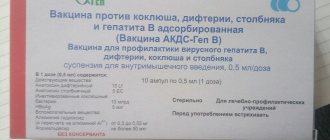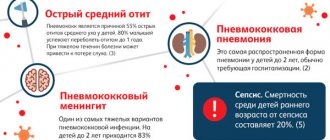My three-year-old grandson received several vaccinations in one day: those required by age plus a flu vaccine. Is this possible?
Galina Zaryanko, epidemiologist at the Krasnoyarsk Regional AIDS Prevention and Control Center, answers :
— Vaccines used within the national calendar are allowed to be administered on the same day. The exception is vaccines for the prevention of tuberculosis. But if different vaccinations are given at the same time, the health worker must do it with different syringes and in different parts of the body. And, in any case, one should be guided by the principle of reasonableness.
A person can tolerate the introduction of 10 thousand antigens at the same time. In modern vaccines there may be only a few of them - 7-10. In addition, we are trying to administer combined vaccines against several viruses at once. But the number of injections for children is still limited - there cannot be more than four of them at the same time, that is, we give them in both arms and both legs. We can give even more to adults. If, for example, there is an urgent trip to the USA, but the necessary vaccinations are not available.
There is a national vaccination calendar, and if parents follow it, then there is no need to give several injections at once. But if they miss the required dates, then they need to catch up. But in any case, the pediatrician must take an individual approach.
By the way, the flu vaccine is very good to take together with the pneumococcal vaccine. The combination of these antibodies stimulates each other - vaccinations become more effective. And this will help you get over the flu easier and not develop complications in the form of pneumonia.
Hello. My son is 2.5 months old. At two months old we had 2 vaccinations in the left and right leg at once. Is it possible to do this? For 2 days the temperature was 38, and after that we had nasal congestion, the child is either breathing normally or we can hear something It’s squelching somewhere inside. I visited an ENT specialist and prescribed fenistil and Kyzyl May oil. but so far no results. What should I do? And is it worth getting vaccinated at 3 months if the runny nose persists?
Hello, I absolutely do not understand why your child received two vaccinations at 2 months. In general, vaccination against hepatitis B begins in the maternity hospital, then the second vaccination is given at 1 month, and the third at 6 months. At 3 months, DTP and polio are done; most likely, you had these two done a month earlier. Of course, this is not scary, these vaccines are compatible, especially since you were given inactivated polio (the only one available in injections), but now you should receive the next DTP + polio vaccination not at 3, but at 3.5 months. For more information, you can look on the Internet for the vaccination calendar adopted in the Russian Federation, or go to my website, where you can also find the calendar in the article about frequently ill children.
I got vaccinated against Covid, I share my impressions: I wouldn’t wish it on my enemy, people stay away from the vaccine!
Good day to all. Some of my subscribers remember that in August I already created a similar article and quickly deleted it. The fact is that my husband was misinformed at work and was eventually vaccinated against the flu, although lists were collected as for Covid.
Doctors were vaccinated so early because the difference between vaccinations should be 3-4 weeks.
Then they started collecting lists for Covid. It should be noted right away that vaccination is voluntary for doctors, no matter what anyone says. My husband was allowed to include me as a family member. True, this surprised everyone at the clinic later.
And now about how I felt the next day:
-I couldn’t get out of bed for a long time because of the feeling of aches and weakness throughout my body;
-the injection site hurt for quite a long time;
-I was unsteady along the way: I carry a blood pressure monitor with me due to periodic surges in pressure, I measured it - 155/110;
-after 14.00 the temperature began to rise, I took the thermometer with me, expecting side effects: 38.5 on the electronic one and even higher by 0.7 on the mercury one at home; took paracetamol and continued working;
-after 18.00 an unimaginable headache began in the back of the head, which was not relieved by pills.
After 20.00 I finally crawled home and lay down.
My husband didn’t take his temperature, but he also had a “flu-like” condition. All his colleagues are the same as me. And at the second vaccination, no matter who was asked, everyone was “flattened” after the first.
What I mean is that officially 15% experience side effects, but we couldn’t all be among those 15))))
Let me reassure you right away that it’s easy to get through the second vaccination, no discomfort.
The second vaccination was on October 26th. Both times we received certificates, but all the information is reflected in the electronic medical record.
I found an article on the Internet specifically about this stage of vaccination; it confirms the authenticity of the certificate, since the specified address is included in the list and provides information about the number of doctors vaccinated within its framework.
COVID-19 vaccination: the main thing you need to know
How safe is the coronavirus vaccine? Why is vaccination necessary, is it possible to do without it, are there any contraindications? How to combine vaccination against COVID-19 with other vaccines included in the National Calendar? Sergey Shkitin, an expert from the All-Russian Union of Insurers, will answer these and other questions. Innate immunity is not always able to resist pathogens of severe and intractable infectious diseases, such as hepatitis B, tetanus, tuberculosis, measles, polio and many others. Since such infections are highly contagious (contagious), and sick people can infect healthy people, one of the key tasks is to stop the spread of infection and avoid an epidemic. In addition, treating infectious diseases is much more difficult than preventing them. Therefore, they try to prevent infections. Vaccination is one of the most effective ways to create both individual and collective immunity against many infectious diseases, including coronavirus infection.
Can all vaccinations be done free of charge under the compulsory medical insurance policy?
In Russia there is a National Calendar of Preventive Vaccinations, within the framework of which vaccinations are carried out at a certain age for children and adults. Vaccinations included in the calendar are provided to those insured under compulsory medical insurance free of charge.
Since December 27, 2021, the vaccine against the new coronavirus infection has been included in the Calendar of preventive vaccinations for epidemic indications. Vaccination against COVID-19 with the first Russian vaccine “Sputnik V (Gam-Covid-Vac)” is available to every insured person free of charge if they have a compulsory health insurance policy. How to combine vaccination against COVID-19 with the mandatory ones included in the National Calendar?
In such a difficult epidemic situation, it is important to get vaccinated against COVID-19, although the decision to vaccinate is made by the person himself. By law, vaccination in Russia is voluntary.
Vaccinations against COVID-19 are generally compatible with vaccinations according to the National Calendar, but in each specific case the final decision on the presence or absence of indications/contraindications for the patient is made by the attending physician based on the collection of complaints, anamnesis, examination, and in some cases also taking into account instrumental and laboratory research methods.
We must understand that when faced with a virus or bacteria that causes a serious illness, an unvaccinated person risks his health, and often his life. Once the proportion of the population protected by vaccination reaches 90 to 95 percent, the pathogen has little chance of spreading widely and causing an epidemic.
But if vaccinations are ignored, the conditions may become ripe for outbreaks of infections that can be effectively controlled by vaccination.
In the fall, many people got a flu shot. Can this vaccine be combined with the COVID-19 vaccine?
The flu shot does not in any way protect against COVID-19 - although the diseases are similar in many symptoms, the viruses that cause them are different. There are no absolute contraindications for combining vaccination against coronavirus infection and influenza. Likewise, the compatibility and advisability of simultaneous use of vaccines in each individual patient should be determined by the attending physician. Who should not be vaccinated against COVID-19?
Contraindications to the administration of vaccines against coronavirus infection are indicated in the instructions for their use. The main contraindications (using the example of Sputnik V, Russian name Gam-COVID-Vac) are hypersensitivity to any component of the vaccine, a history of severe allergic reactions, exacerbation of chronic diseases, pregnancy and breastfeeding, age under 18 years and severe post-vaccination complications, if they occurred after previous vaccinations. A complete list and exact wording of contraindications can be found in the instructions for use of the vaccine. Are vaccines safe?
Vaccines that have passed state registration and are officially approved for use are safe - this fact is recognized by the registration authority that issues permission for their use. Vaccination against one disease does not weaken a person's immune response to another disease. Vaccination does not create any additional risks for a person who has been in contact with an infectious patient or is in the incubation period of the disease.
If you have any questions, you can consult your doctor. Is it better to vaccinate against many diseases at once or vaccinate one at a time? There are combination vaccines that protect against several infections with one shot. For example, a patient may receive vaccines against measles, rubella, and mumps, and diphtheria, whooping cough, and tetanus at the same time.
The frequency and age at which vaccination is required are determined by the Ministry of Health.
Vaccines approved for simultaneous use can be administered in the same syringe (as a combination preparation) or in different syringes in different areas of the body.
If it is not possible to administer two or more vaccines at the same time, vaccinations are given in stages. For example, according to the instructions for use, the yellow fever vaccine is not administered simultaneously with others in children under 15 years of age. But in each case, the decision is made by the attending physician.
Why do you need to sign voluntary consent for medical intervention?
Giving informed voluntary consent before medical intervention is a requirement of Art. 20 of the Federal Law on the Fundamentals of Protecting Citizens' Health. In this case, such consent must contain, inter alia, information about:
- goals, - methods of providing medical care, - the risk associated with them, - possible options for medical intervention, - about its consequences, and also: - about the expected results of providing medical care.
At the same time, the medical organization is responsible not only for the quality and safety of vaccination (for example, in the event of abscesses arising due to violation of the rules of asepsis and antisepsis), but also, for example, for the completeness of collecting an allergic history (in particular, in the event of allergic reactions).
During vaccination, undesirable reactions may occur (for example, fever, various systemic reactions), which are indicated in the instructions for use. In informed voluntary consent, the patient assumes the risk of their occurrence, but only in cases where medical care is provided properly.
IMPORTANT!
In case of refusal to provide medical care, as well as any questions related to the procedure for obtaining and the quality of medical care provided, the rights of patients in the compulsory health insurance system (CHI), please contact your medical insurance organization (IMO) by calling the 24-hour hotline, indicated on the CMO website on the Internet. Write down the number of the medical insurance organization in your phone address book, let it always be at your fingertips.
Previously on the topic:
- Where in Tver you can sign up for vaccination against coronavirus
- Four more hospitals in the Tver region began vaccinating against coronavirus
- How will vaccination against coronavirus be carried out?
- The cost of one dose of the Russian coronavirus vaccine has been announced
- Coronavirus vaccine: indications, contraindications and list of priority groups for priority immunization
- How are countries developing a coronavirus vaccine?
Now about the effect, that is, antibodies.
It was recommended to take the test no earlier than a month after the second vaccination. But my husband regularly takes them at work.
After the first vaccination, the antibody level, which was around 7, increased slightly. And on analysis 10 days after the second it became 12.4. Lasting immunity is considered to be that above 10. It is clear that in another 20 days the numbers will only increase, so the husband was excluded from the ranks of those regularly tested for Covid and antibodies. Now his veins can rest)
I consciously went to classes with a family quarantined due to illness 2 weeks after the second vaccination and did not get sick)))
My antibody test results
Even if a person does not develop antibodies after vaccination, they will develop T cells or “memory cells” that will begin to produce antibodies when they encounter the real virus. Therefore, there is no need to immediately say that the vaccine did not work.
At first, the authorities talked about the start of mass vaccination in November-December. Now the dates have been moved to January-February. There's plenty of time to think.
Repeated vaccination in 3 years, but perhaps they will correct their opinion. Now all I have to do is get the flu shot.
Every year, pediatricians carry out routine vaccination of children, which is determined by the schedule of the national calendar. 2021 was no exception, although scheduled vaccinations have been temporarily suspended since March due to the coronavirus pandemic. But as the self-isolation regime is lifted in the capital and regions, doctors are returning to routine preventive appointments with patients and immunizations. In general, vaccination of children in Russia 2021 is carried out according to the calendar, which is pre-approved by Rospotrebnadzor. The schedule itself is periodically reviewed and supplemented with new vaccinations; immunization includes all new vaccines that are registered in the Russian Federation.
Although this year the schedule for some children has shifted somewhat due to the temporary introduction of restrictive measures related to the coronavirus pandemic, in general, the vaccination scheme for children in Russia in 2020 has not undergone any fundamental changes. Although, due to the current situation, it is quite possible that as a new vaccine against COVID-19 is developed, it will be included in the National Calendar next year as one of the mandatory vaccinations.
Today, children are vaccinated according to the calendar approved by order of the Ministry of Health of the Russian Federation dated March 21, 2014 N 125n (with additional amendments and additions dated June 16, 2021, April 13, 2021, April 24, 2019).
The Calendar contains vaccinations for both children and adults of different ages; it is a guide to action for all pediatricians and therapists, family doctors and specialists from private medical institutions involved in immunization of children and adults.
In addition to the mandatory vaccinations included in the National Calendar, there is also a group of recommended (additional) vaccinations that may be recommended for some children and adolescents, and are also required for traveling outside the Russian Federation, to countries where a number of diseases are endemic.
Compatibility of vaccines with each other
Most vaccines have antigenic, clinical and immunological compatibility: their immediate correct use does not suppress the specific immune response and does not increase the likelihood and severity of side effects. When implementing the current vaccination calendar, two types of immunobiological preparations are used.
Live vaccines:
- MMR (measles-mumps-rubella);
- OPV (polio vaccine drops);
- against rotavirus infection;
- from chicken pox;
- anti-influenza (in drops).
Inactivated (killed) vaccines:
- DTP (pertussis-diphtheria-tetanus);
- IPV (injection polio vaccine);
- against pneumococcal infection;
- from hepatitis (A and B);
- anti-influenza (by injection);
- from meningococcal infection;
- against hemophilus influenzae infection.
The simultaneous administration of vaccines is practiced in accordance with the recommendations of epidemiologists and immunologists, established by the Ministry of Health of the Russian Federation.
- two or more inactivated biological products are administered simultaneously - on the same day in different syringes to different anatomical areas or on any other day;
- vaccination with two or more inactivated vaccines and one live biological product can also be carried out on the same day, distributing them into different syringes and different anatomical zones or at any other interval;
- two or more live vaccines can be used either simultaneously - on the same day, but in different syringes and in different anatomical areas, or with a time interval of at least 4-5 weeks.
The exception is the live BCG vaccine: it is compatible only with a biological product against hepatitis B; it must be performed separately from all other vaccinations and at an interval of at least a month.
Can I give the flu vaccine along with measles?
Both live and inactivated influenza vaccines are given on the same day with any vaccinations from the National Calendar, except BCG. If it is not possible to vaccinate against influenza and measles at the same time, a break of 4-5 weeks is taken between the MMR and any (live or killed) influenza vaccine.
Are DTP and measles vaccination compatible?

The vaccination calendar provides for complex immunization with DPT with vaccines against polio, hepatitis B, pneumococcal and hemophilus influenzae infections.
If it is necessary to restore the calendar schedule (more often when traveling abroad), the World Health Organization recommends the simultaneous administration of all immunobiological drugs indicated for a child or adult according to their age.
Clinical practice has shown that local reactions to PDA are observed somewhat more often if DTP was simultaneously introduced into another anatomical zone. However, titers of immunoglobulins that form reliable protection against infections were similar to those in children vaccinated with monovaccines.
If there were pronounced vaccine reactions in response to the previous administration of DTP, then an interval of at least 45-60 days is maintained between it and the CCP.
Is it possible to get vaccinations against hepatitis, polio and DTP together?
Immunobiological preparations for the formation of immunity to hepatitis, diphtheria, whooping cough, polio and tetanus are recommended by specialists for simultaneous administration. Antigens of the causative agents of these diseases are included in the combined six-component vaccines Infanrix Hexa and Hexaxim and are administered comprehensively in one syringe.
Preparing to vaccinate children
Although vaccinating children is a voluntary choice for parents, it is important to carefully consider the decision. There is no punishment for parents for refusing vaccination in our country, but vaccinations are designed to protect children from serious pathologies. If you do not vaccinate and your child gets one of the “vaccine” infections, the parents will be responsible for the consequences. If the decision to schedule vaccinations is made, parents sign an advisory document - voluntary and informed consent. If they are against vaccinations, they sign a corresponding document with a refusal. Preparation for vaccination of children in Russia 2021 is no less important.
Vaccination can only be carried out in medical institutions that are licensed to provide such services - these can be private and municipal medical institutions.
Before vaccination, the child is examined by a doctor; he must be absolutely healthy. One or several vaccinations can be performed on one day (usually they are given with combined vaccines). In addition, it is important to prepare the child at home and within the walls of a medical institution, especially if we are talking about very young children.
At the time of vaccination, the child must be completely healthy; this significantly reduces the risk of side effects and reactions to the administration of drugs. If we are talking about young children, before the planned vaccination they are not given new foods, contact with people is limited as much as possible in order to avoid the risk of contracting ARVI. The baby should not have fever, malaise, or bowel problems at least 3 to 4 days before vaccination.
After ARVI or any other illness, at least 2 - 4 weeks should pass (depending on the severity of the condition). Before vaccination, the child will be carefully examined by a doctor and asked questions about how he has been feeling in recent days.
Also, blood and urine tests may be indicated for babies before vaccination, especially when vaccination coincides with scheduled medical examinations (3, 6 and 12 months). If a child has certain pathologies - neurological, cardiac, chronic diseases, permission to undergo vaccination is given by a highly specialized doctor. If there are certain deviations in the condition, a temporary medical withdrawal may be given.
Indications
All vaccinations have their own reasons for prescribing vaccination. In general, indications for vaccination of children in Russia 2021 can be divided into 2 groups:
1. Routine vaccination within the framework of the National Calendar by age.
2. Vaccination according to epidemic indications. This includes vaccinations carried out:
- during outbreaks of certain infectious diseases (for example, measles, brucellosis, meningitis);
emergency prevention of diseases if the child is exposed to a specific infection;
vaccination for travel to areas where the risk of certain diseases is high.
For vaccinations that are not included in the vaccination schedule, the indications are similar.
Simultaneous administration of vaccines
home
Information
For patients
General issues
Simultaneous administration of vaccines
- Theoretical basis for simultaneous administration of vaccines
- Safety during coadministration of vaccines
- Efficacy when multiple vaccines are administered simultaneously
- Prevalence of simultaneous administration of vaccines
Vaccines can, and sometimes must, be administered simultaneously. In cases where vaccines cannot be administered on the same day, they are administered at intervals of at least 3-4 weeks. On the other hand, an exception to the last rule is vaccination against rabies for emergency reasons (after a bite). In this case, the threat of developing an infection (which remains 100% lethal) outweighs all other arguments. In fact, the only unacceptable combination of vaccines is the simultaneous administration of cholera and yellow fever vaccines, in which case their immunogenicity suffers. In such cases, it is recommended to either postpone vaccination against cholera, or still vaccinate at once, agreeing to less guaranteed effectiveness.
Theoretical basis for simultaneous administration of vaccines
In order to understand why this is possible, we must understand and accept that the immune system is multitasking. That is, for each introduced antigen, separate antibodies are produced, simultaneously and in parallel. The number of introduced antigens does not play a big role; the reserve capacity of the immune system significantly exceeds the number of antigens that are practically introduced during the simultaneous administration of vaccines.
In the human body, there are simultaneously billions of cells responsible for immunity, although several thousand of them are needed to develop immunity to one of the antigens. The introduction of a thousand antigens (that is, almost simultaneously of all the vaccines registered in the world) simultaneously involves about a million cells, say, even several million - the reserve capacity of the immune system is obvious. Moreover, each cell responsible for immunity works in parallel on several tasks and sometimes can simultaneously “process” (for example, macrophages) several antigens.
Thus, “overloading the immune system” with simultaneous vaccination is just a common myth about vaccinations.
Safety during coadministration of vaccines
The safety of vaccination with separate drugs is exactly the same as with their simultaneous administration. Adverse reactions to vaccinations do not tend to intensify or mutually potentiate with the parallel administration of several antigens. For example, the simultaneous administration of DPT and OPV will not mean an arithmetic summation of the probabilities of adverse reactions (about 30% for DPT and 5% for OPV) - the risk of developing reactions will be calculated according to the maximum indicator, that is, 30%.
With safety in mind, it should be noted that only a few vaccines can be combined in one syringe; as a rule, all vaccinations are administered simultaneously to different limbs. In order for vaccines to be mixed, the instructions for these drugs must contain clear instructions in this regard. In particular, among imported vaccines, it is recommended in Russia to mix Act-HIB and Tetrakok vaccines in one syringe.
Efficacy when multiple vaccines are administered simultaneously
A significant number of studies confirm the absence (except for the examples given above) of mutual influence on the effectiveness of vaccines when administered simultaneously. Thus, for the combination of DTP vaccines and the vaccine against Haemophilus influenzae infection, identical effectiveness of the components was shown both when administered separately (on different days), and when administered combined (in one syringe) and combined (on the same day, in different places). Thanks to this knowledge, various combination vaccines appear, examples of which include PentAct-HIB (Tetracok + Act-HIB), and even such unusual combinations as Tetagrip (tetanus toxoid (Tetavax) + Vaxigrip). , "Twinrix" (hepatitis A + hepatitis B).
Prevalence of simultaneous administration of vaccines
In fact, any combination vaccine is a combination of several vaccines in one syringe. For example, DPT contains three vaccines (diphtheria toxoid, tetanus toxoid, pertussis vaccine), OPV three more (3 types of polioviruses), that is, the combination of DTP + OPV gives a total of six vaccines. The number of simultaneously introduced antigens (that is, specific proteins to which antibodies are formed) is several dozen. In developed countries, vaccines that simultaneously contain six components are now widely used - vaccines against diphtheria, tetanus, whooping cough, hepatitis B, Haemophilus influenzae, and polio.
Situations often arise when it is necessary to administer a much larger number of vaccines. Typically, such situations arise when emigration is necessary, when the number of vaccinations available to the child urgently needs to be increased to the number required by the receiving country. In this case, DPT, polio vaccine, vaccines against measles, mumps, rubella, hepatitis B, and Haemophilus influenzae are administered simultaneously. Practical experience of such forced massive vaccinations has proven that the safety indicators of vaccination do not suffer - the number of adverse reactions does not increase. Naturally, such simultaneous vaccinations with all calendar vaccines should be avoided, observing the time limits prescribed for vaccination.
Other situations where simultaneous administration of vaccines is required include:
- Missed vaccinations - in this case, in practice, all vaccines missing by age are administered;
- Inability to visit a clinic (or vaccination center) in the future;
- Preparing for pregnancy;
- Preparing for the trip;
- Pre-epidemic situation, when in addition to the usual vaccinations, those whose need is dictated by the epidemiological forecast are added.










